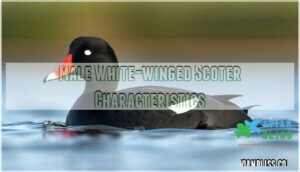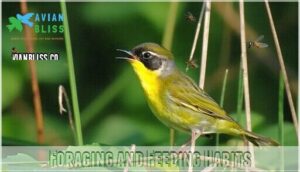This site is supported by our readers. We may earn a commission, at no cost to you, if you purchase through links.

Males showcase striking orange-red bills with black knobs and velvety black plumage, while females display brown coloring with pale underparts and distinctive white facial patches.
These robust diving ducks excel at plunging 5-10 meters deep to hunt mussels, clams, and crustaceans along North America’s coastlines.
During breeding season, they nest in boreal forests before migrating to coastal waters where they form massive flocks.
Their specialized diving abilities and preference for shellfish-rich waters make them perfectly adapted marine specialists.
Understanding their seasonal patterns and unique identification features reveals fascinating insights about their remarkable underwater hunting strategies.
Table Of Contents
- Key Takeaways
- Identification and Range
- Behavior and Diet
- Nesting and Reproduction
- Conservation Status and Threats
- Similar Species and Identification Tips
- Fun Facts and Interesting Insights
- Frequently Asked Questions (FAQs)
- What is a white-winged scoter?
- Where do white winged scoters live?
- What kind of bird is a white-winged scoter?
- What is the difference between Stejneger’s scoter and white wing scoter?
- How big do white winged scoters get?
- Are white winged scoters benthic?
- What does a white winged scoter look like?
- Is a white wing scoter a ‘velvet’?
- What does a scoter look like?
- Are white winged scoters migrating?
- Conclusion
Key Takeaways
- You’ll spot them by their striking white wing patches that flash dramatically during flight, plus males showcase distinctive orange-red bills with black knobs.
- They’re expert underwater hunters who dive 5-10 meters deep (up to 60 feet) and hold their breath for over a minute to catch mussels, clams, and crustaceans.
- You’ll find them following predictable migration patterns from boreal forest breeding grounds to massive coastal flocks during winter months.
- They’re conservation success stories with stable populations, though they face ongoing threats from oil spills, climate change, and coastal habitat loss.
Identification and Range
You’ll recognize White-winged Scoters by their distinctive features that vary dramatically between males, females, and young birds.
These stocky diving ducks show up along coastlines during migration and winter months, making them easier to spot when they’re not scattered across remote northern breeding grounds.
Male White-winged Scoter Characteristics
Spotting a male white winged scoter feels like finding nature’s tuxedo-clad gentleman.
These elegant sea ducks wear nature’s formal attire with unmistakable style
These distinctive birds showcase remarkable features that set them apart from other waterfowl species. You’ll notice their most striking characteristic first – the distinctive bill with its orange-red coloration and prominent knob at the base.
Their bold plumage creates a stunning visual contrast with velvety black feathers highlighted by distinctive white patches on the wings. The white eye patch resembles a comma-shaped marking that adds character to their appearance.
Here are five key identifying features:
- Distinctive bill: Orange-red with black knob creates unmistakable profile
- Bold plumage: Velvety black feathers cover entire body except markings
- Wing patch: White secondary feathers form square patches visible in flight
- Eye patch: White comma-shaped "Viking horn" marking around each eye
- Size comparison: Largest scoter species with stocky build and thick neck
These male characteristics make identification straightforward during breeding season.
Female White-winged Scoter Characteristics
Female White-winged Scoters display distinctive plumage patterns with dark brown upperparts and pale underparts.
Their dark bill shape differs from males, lacking the orange coloration and knob.
Two prominent white facial patches serve as key eye markings for identification.
The feather color creates excellent camouflage while nesting.
These female characteristics make scoter identification straightforward during bird identification efforts.
Immature White-winged Scoter Characteristics
When you’re identifying immature White-winged Scoters, you’ll notice they’re caught between childhood and adulthood in the bird world.
These young scoters present unique challenges for bird identification enthusiasts because their plumage development differs substantially from adults.
Key immature characteristics include:
- Bill shape and color: Dark bills without the orange-red coloration or distinctive bulge found in adult males
- Feather color patterns: Dark brown plumage above with paler underparts, lacking the striking black and white contrast of mature birds
- Molt patterns: White wing patches visible during flight, though other white markings haven’t developed yet
Immature males show whitish bellies and generally darker overall coloration compared to females.
Their juvenile traits make WhiteWinged Scoter identification tricky since they lack the "Viking horn" eye patches and vibrant bill colors.
These scoter identification features develop gradually as birds mature, creating a fascinating period of change for observers studying immature male specimens.
White-winged Scoter Habitat and Migration Patterns
White winged scoter populations follow distinct migration patterns between their northern breeding sites and coastal wintering grounds. You’ll find these birds nesting in boreal forests near large lakes across Alaska, northern Canada, and the northwestern United States during summer months.
When winter approaches, they travel impressive distances along established flyway patterns to reach marine habitats on both Atlantic and Pacific coasts. Understanding the importance of a habitat first approach is essential in identifying species like the white-winged scoter.
| Season | Primary Habitat | Location Examples | Key Features |
|---|---|---|---|
| Breeding | Boreal lake areas | Alaska, northern Canada | Dense shrub cover near water |
| Molting | Coastal estuaries | St. Lawrence, James Bay | Nutrient-rich staging areas |
| Migration | Various flyways | Great Lakes, New England | High-altitude overland flights |
| Winter | Coastal waters | Nova Scotia to New England | Shellfish-rich marine zones |
Their coastal migration showcases remarkable site fidelity, with over 80% returning to the same wintering grounds annually, demonstrating a strong connection to their wintering grounds and preferred habitat.
Behavior and Diet
When you watch White-winged Scoters in action, you’ll witness some of the most skilled diving ducks in North America as they master underwater hunting techniques that few other waterfowl can match.
These remarkable birds demonstrate complex feeding behaviors and social patterns that change throughout the seasons, showing remarkable adaptability in their habits.
Foraging and Feeding Habits
Understanding how you can spot a White-winged Scoter leads naturally to observing their foraging behavior. These skilled divers employ sophisticated diving techniques to hunt beneath the surface.
Their feeding strategies involve powerful underwater propulsion using webbed feet. Aquatic diet preferences include:
- Mussels pried from rocky surfaces
- Clams and oysters swallowed whole
- Crustaceans and amphipods
- Aquatic invertebrates like marine worms
- Seasonal insects during spring months
Shellfish consumption dominates their feeding habits. They use strong bills to break shells or swallow prey entirely. Their gizzards crush hard shells internally.
Foraging occurs in both saltwater and freshwater environments depending on season and availability. The White-winged Scoter’s diet consists of food sources that are similar to Diving Duck Food options.
Diving Behavior and Capabilities
Watch these diving ducks plunge headfirst into action with remarkable precision.
White-winged Scoters demonstrate extraordinary diving abilities through their powerful leg strokes and partially opened wings for underwater navigation.
Their dive depth typically ranges 5-10 meters, though they can reach recordbreaking dives of 25-27 meters when pursuing prey.
Breath control becomes essential during their 25-40 second underwater expeditions, with some dives exceeding one minute.
Between dives, they surface for 20-30 seconds to replenish oxygen stores.
Their streamlined bodies and dense plumage reduce buoyancy, enabling efficient submersion and impressive diving speed.
These sea ducks employ sophisticated feeding tactics during their bird diving sessions.
They use sight to locate prey in low-light aquatic environments, then employ their bills to dig into sediments and pry food from surfaces.
Their diving behavior adapts to environmental conditions like water temperature, clarity, and tidal cycles, making them remarkably versatile underwater hunters.
Diet Composition and Preferences
Spotting a White-winged Scoter at mealtime reveals their shellfish diet preferences.
These diving ducks demonstrate remarkable foraging habits, with mollusks dominating their winter menu.
- Mollusk prey: Mussels and clams comprise up to 95% of marine diet, with soft-shelled varieties preferred during high-energy periods
- Aquatic insects: Breeding season brings increased consumption of larvae and adults, reaching 35% of freshwater intake
- Marine invertebrates: Crustaceans like amphipods supplement their shellfish diet during periodic periods
- Seasonal shifts: Diet changes from 80% mollusks in winter to varied invertebrates during breeding
- Foraging depths: They’ll dive 2-6 meters for benthic prey, occasionally reaching 13 meters for larger shellfish
Social Behavior and Flocking Patterns
You’ll often see these social birds forming impressive flocks during migration patterns, especially when heading to wintering grounds.
Bird watchers love spotting their group behavior as hundreds fly in long, wavering lines low over water.
Their flock dynamics create spectacular displays, with social bonds keeping formations tight.
Communication styles help coordinate movements.
These social habits extend to mixed groups with surf and black scoters, making bird species behavior fascinating to observe.
Nesting and Reproduction
White-winged Scoters begin their breeding cycle in late spring when they return to northern lakes and ponds.
You’ll find their carefully hidden nests tucked away in dense vegetation, where females take on most parenting duties while males often leave after mating.
Nest Placement and Description
White-winged Scoters choose nest sites carefully in dense shrub cover, typically 100-875 yards from water.
You’ll find their nest placement on dry ground among thick vegetation that provides excellent camouflage.
These secretive birds construct simple ground nests using available nest materials like grasses, leaves, and down feathers.
Their nesting habits reflect a preference for privacy during this vulnerable period.
The construction of scoter nests involves understanding scoter nest materials and placement to appreciate their nesting habits fully.
Incubation and Brooding Behaviors
Female White-winged Scoters handle egg incubation solo for 25-30 days.
You’ll find these dedicated mothers carefully covering their clutch with down when leaving to feed.
During brooding behaviors, they shelter ducklings under their wings for warmth and protection.
The female’s parental care continues until young can regulate their body temperature independently, typically lasting several weeks after hatching.
Mating and Breeding Habits
After successful incubation, the real action begins with courtship rituals that showcase nature’s drama.
Male White-winged Scoters put on quite the show to win their mates:
- Elaborate displays: Males perform wing-flapping and head-bobbing dances that catch female attention
- Vocal competitions: Low-frequency whistling calls announce their readiness for mating
- Group courtship: Up to 10 males may compete around one female in water-based displays
- Pair bonding: Bonds form on wintering grounds as early as February before migration
- Breeding seasons: Peak mating occurs when water temperatures reach 10°C in late spring
These courtship behaviors guarantee synchronized arrival at nesting habits locations, boosting reproductive success through early mate selection.
Parenting and Fledging
After successful mating and nesting, you’ll find female White-winged Scoters shouldering all Brood Care responsibilities alone.
These dedicated mothers provide Parental Investment through brooding their precocial ducklings initially, but the young quickly become independent.
Chick Rearing involves minimal guidance as ducklings instinctively forage within days of hatching.
Fledging Age occurs around 63-77 days, marking when juveniles achieve flight capability and complete independence from maternal care.
Conservation Status and Threats
You’ll want to understand how White-winged Scoters are faring in today’s changing world since their survival depends on healthy coastal waters and undisturbed breeding grounds.
These remarkable diving ducks face mounting pressures from oil spills, pollution, and climate change that threaten both their ocean wintering areas and northern lake breeding habitats.
Current Conservation Status
You’ll find the White-winged Scoter classified as "Least Concern" by conservation organizations, yet population trends reveal concerning regional declines.
With global numbers reaching 800,000-1,000,000 birds, these diving ducks face mounting pressures from oil spills, habitat loss, and climate change.
Conservation efforts now focus on habitat protection and monitoring migratory bird populations across North America.
Population Trends and Projections
Despite recent population monitoring efforts, White-winged Scoters face concerning declines across their range.
Trend analysis reveals sobering statistics that highlight urgent conservation needs.
- Species decline exceeded 50% since the 1950s in core breeding areas
- Southern populations nearly vanished by 1998 due to habitat impact
- Population growth remains slow despite targeted conservation efforts
- Migratory birds like scoters need thorough population conservation strategies
Major Threats and Challenges
You’ll find white-winged scoters facing several serious threats despite their stable population.
Oil spills pose major risks to their coastal wintering areas, while climate change disrupts food sources and habitat availability.
Pollution effects from industrial runoff contaminate shellfish beds they depend on.
| Threat Category | Primary Impact | Affected Areas |
|---|---|---|
| Oil Spills | Feather damage, toxicity | Coastal waters |
| Climate Change | Altered prey distribution | Breeding/wintering grounds |
| Habitat Loss | Reduced nesting sites | Boreal forests |
| Pollution | Contaminated food sources | Marine environments |
| Human Impact | Coastal development | Shoreline habitats |
Human impact through coastal development reduces available habitat, while habitat destruction in breeding areas limits nesting success.
Conservation Efforts and Initiatives
Multiple organizations and researchers are spearheading conservation initiatives to safeguard White-winged Scoters.
You’ll find these bird conservation efforts focus on protecting their essential habitats and addressing environmental threats.
Key conservation initiatives include:
- Habitat Protection – Establishing protected areas around critical breeding lakes and coastal wintering grounds
- Pollution Reduction – Implementing stricter regulations on oil spills and marine contamination in scoter habitats
- Climate Mitigation – Supporting wetland conservation programs that help these diving ducks adapt to changing conditions.
Species preservation programs monitor population trends while conservation efforts target the shellfish beds these birds depend on for survival.
Understanding bird conservation status is vital for developing effective strategies to protect the White-winged Scoter and other species.
Similar Species and Identification Tips
Identifying White-winged Scoters among similar species requires attention to specific field marks that distinguish them from their close relatives.
You’ll find success by focusing on bill color, wing patches, and facial patterns that separate White-winged Scoters from Surf Scoters and other diving ducks.
Differences From Surf Scoter and Stejneger Scoter
White-winged Scoter identification becomes clearer when you know the key differences between these three similar scoter duck species. Beak Shape stands out as the most reliable feature – Whitewinged Scoter males sport orange bills with slight knobs, while Surf Scoter males display massive, blunt bills and Stejnegers Scoter shows heavy swelling at the base.
Feather Color and Head Markings also help distinguish them. Male White-winged Scoters show neat white comma patches around their eyes, contrasting with Surf Scoters’ bold white forehead and nape patches. Wing Patterns provide the clearest field mark – only White-winged Scoters display prominent white wing patches visible both in flight and at rest.
| Feature | White-winged Scoter | Surf Scoter |
|---|---|---|
| Bill Size | Orange with slight knob | Large, blunt, colorful |
| Head Pattern | White comma around eye | White forehead/nape patches |
| Wing Markings | Bold white patches | No white wing markings |
Understanding the surf scoter habits is essential for identifying these species. These bird species comparison points make scoter identification much more manageable in the field.
Key Identification Features and Characteristics
Spotting a White-winged Scoter becomes straightforward once you know what to look for. These stocky sea ducks possess several unmistakable features that set them apart from other waterfowl.
Key identification markers include:
- Distinctive bill with yellowishorange coloration and prominent bulge at base in males
- Wing patches showing bold white secondaries visible during flight and at rest
- Eye markings featuring white patch behind the eye in comma shape on males
- Black plumage covering males entirely except for white teardrops around eyes
- Broad wings and heavy build distinguishing them from smaller duck species
Males display velvety black plumage contrasting sharply with their bright bill coloration. Females show brownish feather patterns above with pale undersides.
The white wing patches remain constant across all ages and sexes, making this the most reliable field mark for positive identification. Understanding scoter identification techniques is essential for distinguishing between similar species.
Similarities With Other Scoter Species
White-winged Scoters share striking similarities with their sea duck cousins.
Scoter Comparison reveals these bird species all possess dark plumage and expert Diving Abilities.
Surf Scoter males display similar black coloring, though their Bill Shapes differ markedly.
Feather Patterns overlap substantially among scoter species, creating identification challenges.
Species Similarity extends to habitat preferences and feeding behaviors.
Melanitta deglandi frequently mingles with other scoters during migration, forming mixed flocks that test even experienced birders’ identification skills.
Fun Facts and Interesting Insights
You’ll discover that White-winged Scoters hold some remarkable records among diving ducks.
These impressive birds can plunge up to 60 feet underwater and hold their breath for over a minute while hunting for shellfish.
Unique Behaviors and Adaptations
Beyond identifying these remarkable ducks, you’ll find their unique behaviors equally fascinating.
White-winged scoters possess extraordinary adaptation mechanisms that set them apart from other waterfowl:
- Advanced Diving Techniques: They can plunge 60 feet deep and hold their breath for over a minute while hunting underwater prey.
- Specialized Foraging Strategies: Their powerful bills work like crowbars, prying stubborn mussels and clams from rocky surfaces with remarkable precision.
- Complex Social Behaviors: During migration patterns, they demonstrate impressive migratory flexibility by forming mixed flocks with other scoter species, showing sophisticated bird behavior patterns that help them navigate vast distances together.
Record-breaking Dives and Feats
These scoters break underwater records with impressive diving abilities.
You’ll witness Dive Depth achievements reaching 98-131 feet while foraging.
Their Breath Holding capacity extends over one minute underwater.
Melanitta deglandi demonstrates superior Dive Speed using wings and feet together.
Their sea duck Feeding Strategies handle extreme Water Pressure efficiently.
Bird watching enthusiasts often compare their performance to Surf Scoter capabilities.
The White-winged Scoter’s physical characteristics, such as its stocky build and thick neck features, contribute to its diving prowess.
| Diving Metric | Average Performance | Record Achievement |
|---|---|---|
| Maximum Depth | 16-66 feet | 98-131 feet |
| Dive Duration | 58 seconds | Over 60 seconds |
| Surface Rest | 12 seconds | Minimal intervals |
| Propulsion Method | Feet only | Wings + feet combo |
| Energy Efficiency | Standard diving | 32-37% improvement |
Interesting Habitat and Migration Patterns
From their impressive diving records, these scoters also display remarkable coastal migration patterns. You’ll witness something fascinating when tracking their movements across North America’s waterways.
Coastal migration becomes particularly striking during fall when massive flocks funnel through specific flyway patterns. These marine birds don’t simply wander – they follow predictable routes with laser precision. Breeding sites in Alaska’s boreal forests connect to wintering habits along both Atlantic and Pacific coasts through well-established corridors.
Here’s what makes their migration patterns extraordinary:
- Coastal water bodies serve as critical staging areas during spring and fall movements
- Marine environments provide essential stopover points for refueling during long flights
- Individual route fidelity exceeds 80% – birds return to identical paths year after year
- Bird habitat preferences shift from inland lakes during breeding to saltwater during winter
- Diving birds like scoters can alter migration timing by months depending on ice conditions
Their connectivity between breeding sites, molting areas, and wintering habits demonstrates remarkable navigation abilities across thousands of miles.
Fun Trivia and Lesser-known Facts
White-winged scoters possess remarkable Scoter Secrets that showcase their Wild Adaptations. These Duck Diving experts can plunge 60 feet underwater and hold their breath for over a minute.
Unlike the Surf Scoter, Melanitta deglandi swallows shellfish whole, crushing them in their gizzard. This ecological significance makes birdwatching these diving ducks fascinating.
The unique behaviors of birds, including their complex social learning behaviors, contribute to their remarkable adaptability and survival strategies.
| Fun Trivia | Measurement | Comparison |
|---|---|---|
| Maximum dive depth | 60 feet | Deeper than 6-story building |
| Breath-holding ability | 1+ minute | Longer than most humans |
| Shell-crushing power | Entire mollusk | Gizzard breaks shells |
| Bird Migration distance | Thousands of miles | Alaska to Atlantic coast |
| Feather Facts wing patch | White secondaries | Hidden when resting |
Frequently Asked Questions (FAQs)
What is a white-winged scoter?
Looking at this dark-feathered navigator, you’ll spot a large sea duck with distinctive white wing patches.
Males sport striking black plumage and orange bills, while females display brown tones with pale facial markings.
Where do white winged scoters live?
You’ll find these diving ducks across North America’s coasts and large inland waters.
They breed in northern forests near lakes, then migrate to winter along Atlantic and Pacific coastlines, plus some Great Lakes areas, which can be considered a complete concept of their migration pattern.
What kind of bird is a white-winged scoter?
Diving up to 60 feet deep, you’re observing a large sea duck. White-winged scoters are stocky waterfowl with distinctive white wing patches, orange bills, and expert diving abilities for catching mollusks.
What is the difference between Stejneger’s scoter and white wing scoter?
Distinguishing these species requires sharp eyes. Males of the white-winged scoter have browner flanks, dark yellow coloration of most of the bill and a less tall bill knob, approaching the velvet scoter.
The male Stejneger’s scoter has a very tall knob at the base of its mostly orange-yellow bill. Additionally, the feathering along the base of the upper mandible forms a right angle on the white-winged scoter, compared to the acute angle on the Stejneger’s scoter, which is a key distinguishing characteristic.
How big do white winged scoters get?
White-winged scoters reach impressive sizes, with both males and females measuring 9-8 inches long, weighing 5-5 ounces, and sporting 5-inch wingspans. They’re crow-sized ducks.
Are white winged scoters benthic?
Like underwater treasure hunters, you’ll discover these scoters are indeed benthic feeders.
They dive up to 60 feet deep, using powerful bills to pry mussels and clams from the seafloor, making them specialized bottom-dwelling foragers.
What does a white winged scoter look like?
You’ll recognize this stocky, crow-sized duck by its striking white wing patches and distinctive orange bill with a bulging knob. Males sport velvety black plumage with white comma-shaped eye patches.
Is a white wing scoter a ‘velvet’?
Absolutely no – you’re dealing with completely different species.
While both are sea ducks, White-winged Scoters belong to North America while Velvet Scoters inhabit Europe and Asia, making them distinct cousins rather than the same bird.
What does a scoter look like?
Scoters are stocky diving ducks with thick necks and heavy heads.
You’ll spot their distinctive sloping foreheads and stout bills.
Males display striking black plumage with white wing patches visible during flight.
Are white winged scoters migrating?
Like feathered shuttles weaving between seasons, you’ll spot these impressive birds right now during September’s migration window.
White-winged Scoters leave in September for their wintering grounds along the Pacific and Atlantic coasts, traveling in flocks that showcase their striking appearance.
Conclusion
Knowledge is power when you’re spotting the white winged scoter along North America’s coasts.
You’ve learned to identify their striking white wing patches, orange-red bills on males, and distinctive diving behaviors that set them apart from other waterfowl.
These remarkable marine specialists demonstrate how evolution perfectly adapts birds to their underwater hunting lifestyle.
Whether you encounter them in massive winter flocks or observe their impressive diving skills, the white winged scoter remains one of North America’s most fascinating coastal diving ducks.
- https://swibirds.org/fff/tag/white-winged+scoter
- https://www.bto.org/learn/about-birds/birdfacts/white-winged-scoter
- https://fieldguide.mt.gov/speciesDetail.aspx?elcode=ABNJB17070
- https://www.naturecounts.ca/nc/socb-epoc/species.jsp?sp=whwsco2
- https://www.allaboutbirds.org/guide/White-winged_Scoter/maps-range















